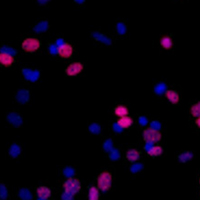IncRNA MAPKAPK5-AS1 promotes proliferation and migration of thyroid cancer cell lines by targeting miR-519e-5p/YWHAH
Thyroid cancer is a common malignant tumour of the endocrine system and ranks ninth in cancer incidence worldwide. An extensive body of evidence has demonstrated that lncRNAs play a critical role in the progression of thyroid cancer. The lncRNA MAPKAPK5-AS1 has been reported to be abnormally expressed and to play a role in the development of various human cancers. However, MAPKAPK5-AS1’s potential role in thyroid cancer progression remains unknown. The objective of our study was to explore the role and mechanism of MAPKAPK5-AS1 in thyroid cancer cells and provide a potential target for its biological diagnosis and treatment. We transfected sh-MAPKAPK5-AS1 and sh-NC into BCPAP and TPC-1 cells for loss-of-function assays. Results of RT-qPCR analysis demonstrated that MAPKAPK5-AS1 was more highly expressed in thyroid cancer cells compared to normal cells. Functional assays demonstrated that interfering with the expression of MAPKAPK5-AS1 notably repressed proliferation and invasion and accelerated apoptosis of BCPAP and TPC-1 cells. Mechanistically, we found that miR-519e-5p was negatively regulated by MAPKAPK5-AS1 and that tyrosine 3-monooxygenase/tryptophan 5-monooxygenase activation protein eta (YWHAH) was a target of miR-519e-5p. Additionally, rescue assays demonstrated that downregulation of MAPKAPK5-AS1 expression inhibited cell proliferation, migration, and invasion and promoted apoptosis by sponging miR-519e-5p, thereby increasing YWHAH expression. Ultimately, our study revealed that MAPKAPK5-AS1 promotes proliferation and migration of thyroid cancer cells by targeting the miR-519e-5p/YWHAH axis, which provides novel insight into the development and progression of thyroid cancer.
How to Cite
PAGEPress has chosen to apply the Creative Commons Attribution NonCommercial 4.0 International License (CC BY-NC 4.0) to all manuscripts to be published.









